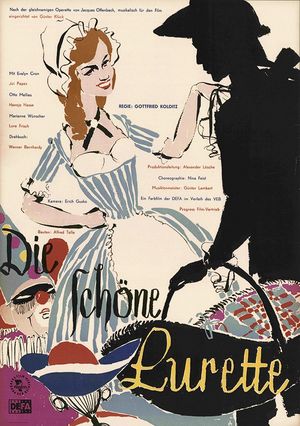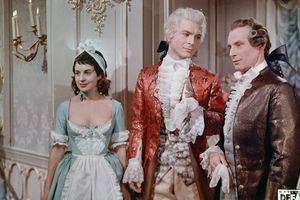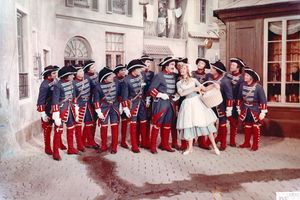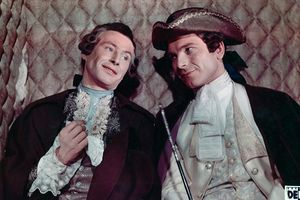Die schöne Lurette
Director: Gottfried Kolditz, 83 Min., Color, Feature Film
Deutsche Demokratische Republik (DDR)
DEFA-Studio für Spielfilme, 1960
- Film/Video Format
- 35 mm
- Length in m
- 2260
- English Title
- Beautyful Lurette
- Premiere Date
- Release Date (for Cinema)
- Literary Source
- Offenbach, Jacques: "Die schöne Lurette", Operettte

(Dir.: Gottfried Kolditz, 1960) Graphic Design: Bert Heller
Short Summary (English)
Two young people, Ric and Klaus, travel to Poland together to spend their holiday there. They are quite proud and happy when they are put up by a friendly man from Cracow who allows them to use his flat freely. They feel accepted and at the same time. Pleasantly and unusually independent. They embark on a journey of discovery and meet very different kinds of people. In conversations and narrations, the past comes to life for them - they experience both embittered people and those who are looking for new links between GDR citizens and Poles. To their surprise. the two young people also discover how differently they respond to people and events.
Because of a misunderstanding, Ric gets into a state of panic, rushes into the street to look for Klaus. He is run over and killed by a tram. In these tragic hours, Klaus experiences sympathy and helpfulness on the part of Polish people. Through them, he understands the huge loss he has suffered and discovers an entirely unsuspected sensitivity and ability to mourn in himself.
Source: Progress Film-Verleih

(Dir.: Gottfried Kolditz, 1960) Photography: Hannes Schneider

(Dir.: Gottfried Kolditz, 1960) Photography: Hannes Schneider
Film Crew
- Director
- Script
-
- Werner Bernhardy
- Camera
-
- Erich Gusko
- Film Editing
-
- Hildegard Tegener
- Cast
-
- Evelyn Cron (Lurette)
- Jiří Papež (Campistrel)
- Otto Mellies (Herzog)
- Hannjo Hasse (Malicorne)
- Marianne Wünscher (Marcelline)
- Lore Frisch (Rose)
- Josef Peter Burgwinkel (Abbé)
- Jochen Thomas (Belhomme)
- Werner Lierck (Merluchet)
- Bodo Mette (Cigogne)
- Rolf Ripperger (1. Geselle)
- Willi Neuenhahn (2. Geselle)
- Frank Peter Rohm (Lehrjunge)
- Jochen Diestelmann (Boiserie)
- Peter Kiwitt (Cadignon)
- Herbert Köfer (Givoy)
- Paul Funk (Haushofmeister)
- Fredy Barten (Tonnage)
- Maria Besendahl (Frau Tonnage)
- Inka Unverzagt (Dienstmädchen / Tänzerin der Pompadour)
- Günter (auch: Günther) Götze (Friseur)
- Marlene Schellong (Kammerzofe)
- Bärbel Ola (Kammerzofe)
- Sylva Schüler (Sängerin)
- Friedrich Teitge (Lakai)
- Georg Irmer (Kleiner Soldat)
- Renate Stropp (Mädchen im Tänzerinnenkostüm)
- Christine Gulland (Mädchen im Tänzerinnenkostüm)
- Astrid Much (Wäscherin)
- Karin Kornatis (Wäscherin)
- Veronika Axmann (Wäscherin)
- Hannelore Laws (Wäscherin)
- Ingrid Pabst (Wäscherin)
- Christa Schillert (Wäscherin)
- Dorit Engler (Wäscherin)
- Erika Grüneberg (Wäscherin)
- Marianne Kuckuck (Wäscherin)
- Sylvia Simdorn (Wäscherin)
- Inge Otto (Wäscherin)
- Gisela Schauber (Wäscherin)
- Vera Byl (Wäscherin)
- Christina Kobs (Wäscherin)
- Gudrun Peters (Wäscherin)
- Rosemarie Schliephake (Wäscherin)
- Brigitte Linke (Wäscherin)
- Ingrid Hackbarth (Palastdame)
- Sonnhild Voswinkel (Palastdame)
- Ilona Schmidt (Palastdame)
- Brigitte Schwandt (Palastdame)
- Gisela Markgraf (Palastdame)
- Sieglinde Kühl (Palastdame)
- Gisela Neuer (Palastdame)
- Erika Thiele (Palastdame)
- Ursula Köppen (Palastdame)
- Sabine Lehmann (Palastdame)
- Trude Anders (Palastdame)
- Ursula Gallasch (Palastdame)
- Renate Flieger (Palastdame)
- Christa Francke (Palastdame)
- Renate Skibbe (Palastdame)
- Christiane Wratsch (Palastdame)
- Irene May (Palastdame)
- Irmgard Lierck (Palastdame)
- Ines Werner (Palastdame)
- Evelyn Exner (Palastdame)
- Helga Wasmer-Witt (Ballettsolistin)
- Isabella von Weech (Ballettsolistin)
- Kurt Kaminski (Ballettsolist)
- Dieter Pose (Ballettsolist)
- Monika Stendner (Gruppentänzerin)
- Helga Dürr (Gruppentänzerin)
- Eva Schirmer (Gruppentänzerin)
- Inge Grunwald (Gruppentänzerin)
- Irmgard Bleichgruber (Gruppentänzerin)
- Ruth Leitzmann (Gruppentänzerin)
- Johanna Freiberg (Gruppentänzerin)
- Marlene Wessel (Gruppentänzerin)
- Dita Döring (Gruppentänzerin)
- Helmut Schindler (Gruppentänzer)
- Werner Wiebach (Gruppentänzer)
- Günther Griebsch (Gruppentänzer)
- Assistant Director
-
- Ursula Pohle
- Assistant Camera
-
- Peter Dietrich
- Production Design
-
- Alfred Tolle
- Script Editing
-
- Hanns Julius Wille
- Music
-
- Jacques Offenbach
- Sound
-
- Günter Dallorso
- Günter Lambert (Musikton)
- Musical Performance
-
- Ingeborg Wenglor (Gesang (Lurette))
- Martin Ritzmann (Gesang (Campistrel))
- Charles Geerd (Gesang (Herzog))
- Leo Wistuba (Gesang (Malicorne))
- Gertrud Stilo (Gesang (Marcelline))
- Sieglinde Goßmann (Gesang (Rose))
- Herbert Rößler (Gesang (Belhomme))
- Alf Pörschmann (Gesang (Cigogne))
- Reiner Süß (Gesang (1. Geselle))
- Irmgard Arnold (Gesang (im Vorspann))
- DEFA-Sinfonieorchester (Leitung: Karl-Ernst Sasse)
- Rundfunkchor Leipzig
- Costume Design
-
- Hans Kieselbach
- Make-Up
-
- Alois Strasser
- Karin Geißler
- Günter Hermstein
- Props
-
- Günter Zaleike
- Production Management
-
- Alexander Lösche
- Unit Production Management
-
- Erich Kühne
- Werner Liebscher
- Design
-
- Nina Feist (Choreografie)
- DEFA Photography
-
- Hannes Schneider
Short Summary (German)
Karneval in Paris zur Zeit Ludwig XV. Die reizende Wäscherin Lurette will das bunte Treiben nutzen, um den etwas schwerfälligen Zimmermann Campistrel eifersüchtig zu machen, damit er ihr endlich seine Liebe gesteht. Der aber ist mit der Fertigung der Spottfiguren für den Umzug beschäftigt. Lurettes Wege kreuzen die des Herzogs von Marly und ihre Pläne die seinen. Mit einer fingierten Hochzeit will er die hübsche Lurette für ein amouröses Abenteuer gewinnen und sie danach dem König als neue Mätresse zuführen. Durch das Eingreifen der couragierten Wäscherin Marcelline, des endlich aktiv werdenden Campistrel sowie der anderen kann die ahnungslos flirtende Lurette vor der schändlichen Intrige des Herzogs gerettet werden. Der Karneval erlebt mit der glücklichen Umarmung von Lurette und Campistrel seinen Höhepunkt.
(Quelle: Das zweite Leben der Filmstadt Babelsberg. DEFA-Spielfilme 1946-1992)
Short Summary (Other Languages)
Ai tempi di Luigi XV, durante i festeggiamenti per il carnevale a Parigi, la bella lavandaia Lurette spera di conquistare il carpentiere Campistrel facendolo ingelosire. I piani della ragazza s'incrociano con quelli del Duca von Marly, determinato a presentarla al Re come nuova amante. L'intervento della coraggiosa lavandaia Marcelline e di Campistrel salvano Lurette dagli intrighi del Duca. I festeggiamenti per il carnevale sfociano nell'abbraccio fra Lurette e Campistrel. (Italienisch)



